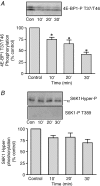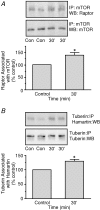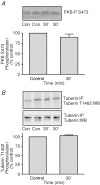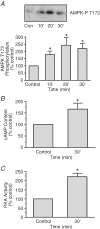Exercise-induced alterations in extracellular signal-regulated kinase 1/2 and mammalian target of rapamycin (mTOR) signalling to regulatory mechanisms of mRNA translation in mouse muscle
- PMID: 16543272
- PMCID: PMC1779730
- DOI: 10.1113/jphysiol.2005.103481
Exercise-induced alterations in extracellular signal-regulated kinase 1/2 and mammalian target of rapamycin (mTOR) signalling to regulatory mechanisms of mRNA translation in mouse muscle
Abstract
The present study examined the effects of an acute bout of treadmill exercise on signalling through the extracellular signal-regulated kinase (ERK)1/2 and mammalian target of rapamycin (mTOR) pathways to regulatory mechanisms involved in mRNA translation in mouse gastrocnemius muscle. Briefly, C57BL/6 male mice were run at 26 m min(-1) on a treadmill for periods of 10, 20 or 30 min, then the gastrocnemius was rapidly removed and analysed for phosphorylation and/or association of protein components of signalling pathways and mRNA translation regulatory mechanisms. Repression of global mRNA translation was suggested by disaggregation of polysomes into free ribosomes, which occurred by 10 min and was sustained throughout the time course. Exercise repressed the mTOR signalling pathway, as shown by dephosphorylation of the eukaryotic initiation factor (eIF)4E-binding protein-1 (4E-BP1), enhanced association of the regulatory-associated protein of mTOR with mTOR, and increased assembly of the tuberin-hamartin complex. In contrast, exercise caused no change in phosphorylation of either Akt/PKB or tuberin. Upstream of mTOR, exercise was associated with an increase in cAMP, protein kinase A activity, and AMP-activated protein kinase phosphorylation. Simultaneously, exercise caused a rapid and sustained activation of the MEK1/2-ERK1/2-p90RSK pathway, resulting in increased phosphorylation of downstream targets including eIF4E and the ribosomal protein (rp)S6 on S235/S236. Overall, the data are consistent with exercise-induced repression of mTOR signalling and global rates of mRNA translation, accompanied perhaps by up-regulated translation of selected mRNAs through regulatory mechanisms such as eIF4E and rpS6 phosphorylation, mediated by activation of the ERK1/2 pathway.
Figures








Comment in
-
Protein synthesis a low priority for exercising muscle.J Physiol. 2006 Jun 1;573(Pt 2):288-9. doi: 10.1113/jphysiol.2006.110247. Epub 2006 Apr 6. J Physiol. 2006. PMID: 16600996 Free PMC article. Review. No abstract available.
References
-
- Alessi DR, Kozlowski MT, Weng QP, Morrice N, Avruch J. 3-Phosphoinositide-dependent protein kinase 1 (PDK1) phosphorylates and activates the p70, S6 kinase in vivo and in vitro. Curr Biol. 1998;8:69–81. - PubMed
-
- Atherton PJ, Babraj J, Smith K, Singh J, Rennie MJ, Wackerhage H. Selective activation of AMPK-PGC-1alpha or PKB-TSC2-mTOR signaling can explain specific adaptive responses to endurance or resistance training-like electrical muscle stimulation. Faseb J. 2005;19:786–788. - PubMed
-
- Bolster DR, Crozier SJ, Kimball SR, Jefferson LS. AMP-activated protein kinase suppresses protein synthesis in rat skeletal muscle through down-regulated mammalian target of rapamycin (mTOR) signaling. J Biol Chem. 2002;277:23977–23980. - PubMed
-
- Castro AF, Rebhun JF, Clark GJ, Quilliam LA. Rheb binds tuberous sclerosis complex 2 (TSC2) and promotes S6 kinase activation in a rapamycin- and farnesylation-dependent manner. J Biol Chem. 2003;278:32493–32496. - PubMed
Publication types
MeSH terms
Substances
Grants and funding
LinkOut - more resources
Full Text Sources
Research Materials
Miscellaneous

